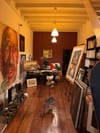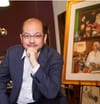- Strengthening cultural ecosystem: Lee Khai highlights the need to link Penang’s art institutions — the Penang Art District and the Penang State Art Gallery — into a cohesive ecosystem supported by sound cultural policies and sustainable investment.
- Governance and inclusivity: He stresses good governance, collaboration, and community engagement to ensure transparency, diversity, and shared ownership in Penang’s growing art scene.
- Vision and legacy: Lee envisions a future where art defines identity and shapes continuity, positioning Penang as a regional hub of creativity grounded in both heritage and innovation
By Sebastian Lim
FOR LEE KHAI, art is not a luxury — it’s an ecosystem. His vision for Penang’s creative landscape blends governance, education, and community engagement into a single framework of sustainability. “Art needs the same discipline as law or business,” he says. “Without structure, creativity can’t endure.” In Part 1, Lee spoke on “The art of building a cultural legacy in Penang”. Here, he shares his expertise on how to strengthen the cultural infrastructure to create a cohesive ecosystem for Penang’s growing art scene.
Infrastructure for creativity
As both chairman of the Penang State Art Gallery (PSAG) and advisor to the Penang Art District (PAD), Lee has worked to link artistic vision with administrative efficiency. “We often forget that behind every exhibition, there must be a system,” he explains. “Curation, funding, logistics — all require planning.”


For Lee, art infrastructure goes beyond physical spaces. It includes policies, education pipelines, and cross-sector partnerships that give artists stability. Under his leadership, PSAG is digitising its archives, expanding curatorial training, and documenting Penang’s artistic evolution.
"The gallery must be more than a showcase,” he insists. “It should be a centre of research, dialogue, and memory.”
At the same time, the Penang Art District is taking shape as a creative hub designed to gather artists, designers, educators and entrepreneurs under one roof. “PAD represents the future — a physical and conceptual space for collaboration,” Lee says. “We’re building a community that values both tradition and innovation.”
Policy and participation
Lee’s legal background enables him to approach cultural development through governance. He believes that Malaysia’s art institutions must evolve from personality-driven projects into professionally managed entities. “Passion must be matched with structure,” he notes. “Without governance, good ideas fade with time.”
He advocates for transparent funding models and stronger policy support. “We need clear standards for acquisition, curation, and grants,” he says. “Artists should know where to go for support, and institutions must be accountable to the public.” This professionalisation, he believes, will help bridge gaps between government, corporations, and the creative community.
“Cultural governance is not bureaucracy,” he adds. “It’s stewardship — ensuring that art serves society and sustains itself.”
Inclusivity and public engagement
Lee is deeply aware that art cannot exist in isolation. He often speaks of the importance of “social oxygen” — the public’s participation in art. “Without engagement, even the best gallery is just a space,” he says.
Under his guidance, PSAG and PAD have begun expanding outreach programmes. These include artist talks, school workshops, and collaborations with community groups to bring art beyond gallery walls. “We must meet people where they are,” he explains. “Art belongs to everyone.”

He is particularly passionate about involving youth and underrepresented communities. “Diversity isn’t just a slogan,” he stresses. “It’s what gives our culture depth and resilience.”
In practice, this means integrating contemporary art with Penang’s living heritage — from mural trails in George Town to artist residencies in traditional neighbourhoods. “Our heritage isn’t a museum piece,” he says. “It’s a living narrative.”
Art as economic driver
Lee also emphasises the economic logic of investing in culture. He points out that the creative industry is one of the fastest-growing sectors globally, contributing significantly to GDP and employment. “When we support art, we’re supporting jobs, education, and tourism,” he explains.
Penang’s strategy, as he sees it, is to position itself as a creative capital of Southeast Asia — a hub for art fairs, festivals, and cross-cultural exchange. “Penang has the history, the talent, and the global connections,” he says. “We just need to amplify and redefine them."
He envisions PAD becoming a model for creative urban regeneration — proving that art can drive development without displacing communities. “It’s about symbiosis, not gentrification,” he clarifies. “Art should enrich lives, not divide them.”
Mentorship and knowledge transfer
For Lee, sustainability also depends on nurturing future leaders. He encourages experienced artists and curators to mentor younger ones. “We need a culture of sharing knowledge,” he says. “Artistry must be matched with professionalism.”


Through workshops and collaborations, he hopes to create a continuous exchange between generations. “Art evolves when experience meets experimentation,” he remarks. “Our institutions must facilitate that dialogue.”
Most recently, Lee co-founded the Commonwealth of World Chinatowns (CWC). This international platform harnesses the resources and networks of the global Chinese diaspora to advance arts, culture, science, and medicine.

CWC is developing an art curatorial education programme, beginning with workshops on art writing and interpretation, exhibition planning and curation, conservation and art handling, photography and documentation, promotion and audience engagement, fundraising and sponsorship, digital curation and new media, collection management, and community education. Over time, CWC aims to evolve this into a structured diploma and eventually a degree programme.

Future of Penang’s art identity
Asked how he envisions Penang’s art scene a decade from now, Lee says, “I hope it will be self-sustaining — confident, connected, and globally engaged.” He imagines a networked creative ecosystem that includes not just visual arts but also design, literature, and digital innovation.
His long-term dream is for PSAG and PAD to serve as twin pillars — one preserving heritage, the other driving innovation. “Together, they define who we are and where we’re going,” he explains.
Legacy of stewardship
Lee’s approach combines humility with foresight. “I don’t see myself as the centre of the story,” he says. “My role is to help build structures that will outlast me.”
His guiding philosophy is simple: art is public trust. “If people see art as part of their daily lives — something that shapes their sense of place and purpose — then we’ve done our job,” he says.
Penang’s creative renaissance, under Lee Khai’s stewardship, is thus not an accident but a design — carefully balancing passion with pragmatism, and imagination with integrity.
In an age where cities compete for attention through economic and digital means, Penang’s quiet yet confident rise as a creative hub stands as a testament to sustained vision and dedication. And the person behind much of that movement is Lee Khai — a man who believes that art is not a luxury but a necessity, a foundation for a more thoughtful and humane society.
Check out Part 1 of the interview with Lee Khai: Art of building a cultural legacy. Click here





